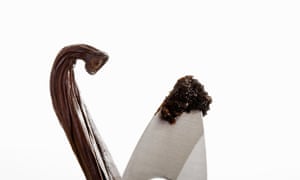
It’s a shortage that could leave a bad taste in the mouth this summer, as food manufacturers grapple with rocketing vanilla prices that threaten to push up the cost of ice-cream.
The price of Madagascan vanilla surged by nearly 150% last year after the island, the dominant producer, experienced a poor harvest. Now food industry executives are reporting a fresh rise in prices as supply tightens.
Charlie Thuillier, the founder and managing director of the ice-cream brandOppo, said the cost of the vanilla extract his company buys has spiked. “The price has doubled in the last month. We were paying €35 a litre in February but now it’s €76,” he said.
Vanilla is the second most expensive spice in the world, after saffron, a result of its long and labour-intensive cultivation.
Part of the orchid family, vanilla beans are hand-pollinated on family farms. Each flower opens for only one part of one day during the season – if it is not pollinated on that day, no pod is produced. Once picked, the curing process, which involves drying the beans in the sun by day and allowing them to sweat in a box at night, takes three to six months.
Silver Spoon, which distributes the American Nielsen-Massey vanilla brand in the UK, said: “The market price of vanilla has risen over the past 12 months, and sharply over the last 12 weeks. This has been driven largely by a poor quality harvest in Madagascar. Our hope is that vanilla prices will return to a more stable level in the future.”
The main producers of food grade vanilla – known as black vanilla because of the colour of the dried pods – are Madagascar, followed by Mexico and Tahiti. As with wine, chocolate and coffee, the vanilla from each country has its own distinctive characteristics but it is Madagascan vanilla that produces the creamy, sweet flavour beloved of Britons.
The data company Mintec says Madagascan vanilla bean was changing hands for £144 a kilogram in January compared with £59 at the start of 2015. “Vanilla prices started rising in 2012-13 due to quality concerns and have continued to rise,” said its analyst Jara Zicha.
There are three main commercial preparations of whole beans, powder, and extract. Extract, made by steeping the ingredient in alcohol, is sold by the “fold” – a unit that denotes the weight of vanilla beans per gallon.

Soaring prices will hurt companies that use the ingredient in everything from soft drinks to cakes and perfume. But the pain will be felt most acutely by ice-cream makers, as it is the most expensive ingredient in the production process and some will be forced to pass on the increased cost to consumers.
Oppo, which counts the tennis player Andy Murray among its investors, buys extract to flavour its “Madagascan vanilla with a hint of baobab” ice-cream.
“You can get vanilla extract all over the world but we chose Madagascar because it had the greatest depth of flavour,” says Thuillier. “Managing the price increase is a bit of a challenge for us but we haven’t changed supplier. If you are doing battle with giants like Unilever you need a product that’s unbelievable. We will sell more.”
When prices are high, market experts say, farmers are tempted to pick beans early. That leads to a less intense flavour, compounding problems in the market. The high-value crop is also a target for criminals.
“There are reports that vanilla farmers in Madagascar harvested their 2015 crop prematurely, in fear of losing their production to thieves,” said Zicha. “This, coupled with inadequate drying in order to increase profits from their crop has led to lower quality vanilla.”
A decent vanilla bean crop in Madagascar is judged to be about 2,000 tonnes, whereas in 2015 it was between 1,300 and 1,400 tonnes. This summer’s harvest will be ready for shipment from November and some industry figures anticipate it will be more bountiful.
Craig Nielsen, the chief executive officer of Nielsen-Massey Vanillas, told Food Business News magazine: “The flowering for [the 2016 crop] was good, and prices may start to drop in the fourth quarter.”
The combination of high prices and poor quality means some manufacturers are turning to synthetic alternatives. But many food brands are not open to using artificial flavourings.
Dave Bishop, the production manager at New Forest Ice Cream, said its vanilla costs have risen by 18.5%. But, he said, there is no option but to pay up: “Vanilla is every ice-cream company’s biggest-selling product. You can bring out a niche flavour but vanilla will still be top. You’ve just got to take the hit on it because customers would notice the difference.”
[Source:- The Guardian]


